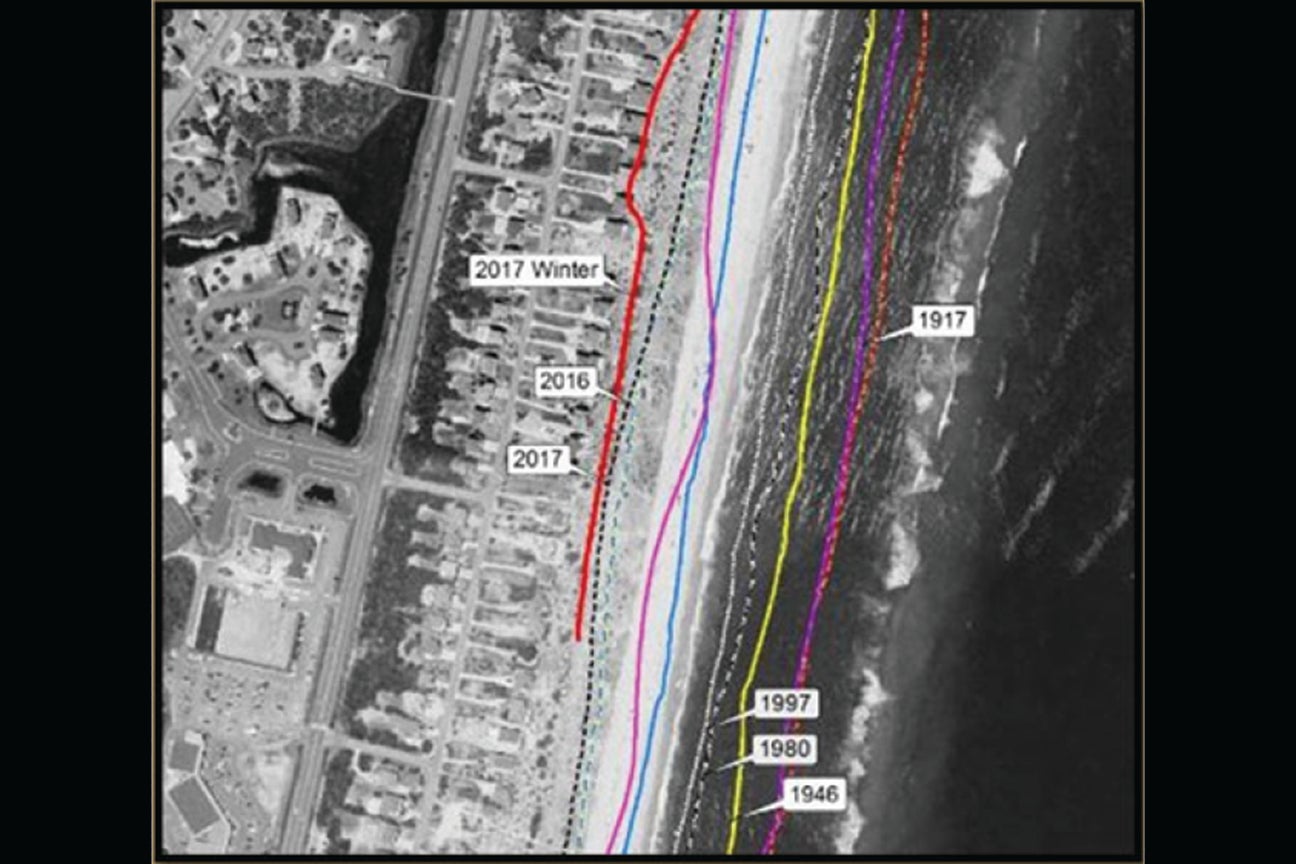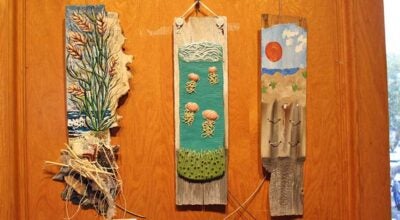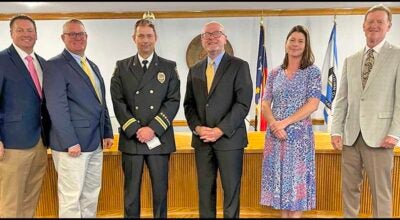Framework under development for sand projects for Cape Hatteras National Seashore
Published 5:26 pm Saturday, April 25, 2020

- Aerial depiction of historical erosion rates in Avon. Courtesy Cape Hatteras National Seashore
|
Getting your Trinity Audio player ready...
|
Over the course of four webinars, 165 people listened to a presentation and then asked questions about the National Park Service’s project to adopt a framework for managing sand projects on Cape Hatteras National Seashore beaches.
Dave Hallac, superintendent for the National Parks of Eastern North Carolina, said: “The public has a longstanding and deep appreciation of their Cape Hatteras National Seashore. Therefore, I was impressed but not surprised by the significant level of public participation during our scoping meetings. The Park Service strongly values public input during the EIS process because it will result in the development of a more effective plan.”
When completed in spring 2021, the framework project will produce an Environmental Impact Statement to serve as an environmental review document for beach nourishment, habitat restoration, dune reconstruction and filling breaches. In the impact statement, conditions for addressing environmental impacts will be spelled out. Meeting those conditions will result in issuance of a Special Use Permit for the proposed work. Having the statement in place will eliminate preparation of an environmental review for every project proposed.
About beach nourishment, Hallac responded that the Cape Hatteras National Seashore does not have the financial means to implement and then maintain beach nourishment projects. Seashore partners make permit requests to implement projects.
High on the list of participant concerns were the Avon Beach Nourishment Project and the Buxton Maintenance and Renourishment Project sponsored by Dare County. For both projects, the purpose is to protect NC 12.
Avon Beach Nourishment Project
On Feb. 18, 2020, Dare County’s commissioners approved a consulting engineering proposal with Coastal Science and Engineering, Columbia, S.C. for preliminary work on the village’s Beach Nourishment Project. The project will cover the area from the Avon Pier to Askins Creek North Drive, a distance of about 1.5 miles.
The proposal timeline calls for the Phase I feasibility study to be ready around the end of August this year. The contract maximum price is $166,960.
“The purpose of the project is to stabilize the shoreline to protect NC Highway 12 and public utility infrastructure from overwash, inundation, and undermining during storm events.”
The schedule, from February through August 2020, calls for finding aerial images, setting up base maps and digital control points in February and March; in April and May, conducting a beach condition survey and sediment sampling, taking offshore borings; through July, analyzing sediment and formulating plan; by end of August, submitting Phase I report.
The consulting engineering proposal from Coastal Science and Engineering can be found on the Dare County website, darenc.com, under Board of Commissioners, click on agenda, minutes and videos for the Feb. 18, 2020 Agenda and going to Item 7.
The Feb. 18 motion authorized county manager Robert L. Outten to sign the contract.
Hurricane Matthew (September 2016) created a 225 foot dune breach along Ocean View Drive, south of the Avon Pier. Since that time, storms have rushed under oceanfront homes, across Ocean View, past another row of houses and flooded NC 12. Ocean water sometimes extends into Kinnakeet Shores Soundside subdivision.
On Tuesday, April 21, Hallac was asked about the possibility of short-term action on Ocean View. He responded that it is always possible to do a short term project, but added that no project for nourishing the beaches has been received.
Various options to rebuild dunes like hardening, installing sand fencing and vegetation were raised. One question explored the impact of Avon Pier on the beach to the south. Rebecca Beavers, coastal geology and adaptation coordinator, National Park Service (Denver), said “we do see impacts around piers.”
Buxton Beach Maintenance-Renourishment Project
On Wednesday evening, the queries concentrated on Buxton.
This project is a combination of FEMA maintenance from Hurricane Florence (September 2018) and Hurricane Dorian (September 2019) and schedule renourishment project for Dare County.
Total estimated project cost is $19.17 million, with FEMA contributing $9 million and Dare County $10.07 million. This is for nourishment only.
The original proposal also looked at restoring existing groins, but that is not included in the Buxton maintenance-renourishment project.
Bidding for a dredging contract is scheduled for January through March 2021 for the project to start in August 2021 or August 2022. The project area is the same area as the previous project, along the beach from Haulover through the Buxton oceanfront, about three miles.
The National Park Service has not issued a permit for the Buxton project. It has not been asked for one. However, the schedule for producing the impact statement and the time that Dare County might request a permit mesh.
“The schedule we’re on is consistent with Dare County’s,” said Hallac.
Present at the April 21, 22 and 23 three webinars were:
David Hallac, superintendent, National Parks of Eastern North Carolina
Mark Dowdle, deputy superintendent, Cape Hatteras/Fort Raleigh/Wright Brothers (Outer Banks Group)
Kelly Daigle, environmental protection specialist for the Environmental Quality Division, Planning and Compliance Division of the National Park Service
Sabrina Henry, environmental protection specialist, Cape Hatteras/Fort Raleigh/Wright Brothers
Tracy Ziegler, chief of Resource Management and Science, National Parks of Eastern North Carolina
Jami Hammond, regional environmental coordinator, South Atlantic-Gulf Region (Atlanta)
Linda York, coastal geomorphologist, South Atlantic-Gulf Region (Atlanta)
Rebecca Beavers, coastal geology and adaptation coordinator, National Park Service (Denver)
Julie Brummer, ecologist/policy/regulatory specialist, Washington Support Office
Monique LaFrance Bartley, marine ecologist, Washington Support Office
Tracy Littell, consultant with VHB (Vanasse Hangen Brustlin, Inc.)
The home page for the Environmental Impact Statement project is parkplanning.nps.gov/CAHASediment. Posted documents include the slide presentation for the webinars, a map showing potential locations for sediment management and the current project newsletter. Documents generated by this project will be posted to this site.
Comments are to be submitted electronically at parkplanning.nps.gov/CAHASediment, the preferred method, or mailed to Superintendent, Cape Hatteras National Seashore, 1401 National Park Drive, Manteo, NC 27954. Deadline to submit comments is May 10, 2020.
READ ABOUT MORE NEWS AND EVENTS HERE.
RELATED:
Building a framework for sand management for national seashore is underway
RECENT HEADLINES:
North Carolina governor seeks to spend $1.4B for COVID-19 aid





